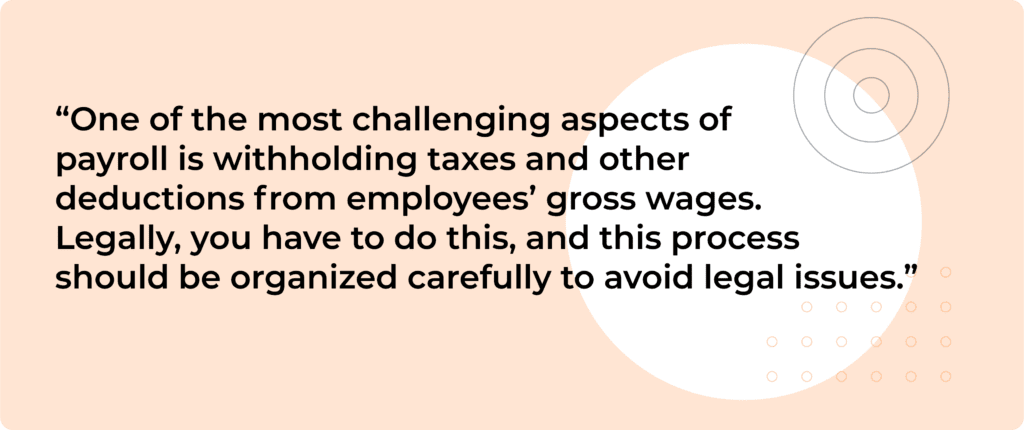
Calculating payroll for a small business is often an underestimated yet crucial aspect of business management. As a small business owner, understanding and effectively managing this process is key to avoiding time-consuming errors and potential legal issues that can arise from payroll mishandling. Whether you’re new to business or looking to refine your existing payroll process, this guide simplifies the journey. We’ll delve into the essential steps for processing payroll, providing clear, practical advice tailored to small businesses. From timekeeping and tracking to understanding deductions and filing taxes, we cover the critical elements that ensure your payroll is accurate, timely, and compliant. Additionally, we’ll touch on options like payroll services and software that can streamline this complex task.
Let’s demystify payroll calculation so you can focus on growing your business with confidence and peace of mind.
What are the steps for processing payroll for a small business?
In order to execute payroll accurately, on time, and in compliance, a payroll service is the best option. But if you decide that you want to take your chances and process payroll manually, you’ll want to familiarize yourself with the basic steps of payroll. Let’s go over each step.
1) Timekeeping and tracking.
It is essential to keep track of how much time your employees spend on the job when running payroll. It is the first step in the payroll process for a small business. The number of regular hours worked, time off, and overtime hours is included in this calculation. In order to ensure that your employees receive the right amount of pay, it is important to retain employee hours.
- For hourly employees, this will be total hours worked.
- For salaried employees, it is a set number of hours agreed upon at the time of hire.
Additionally, you need to select a pay schedule. This is the exact recurring timeline for when you pay your employees. A pay schedule traditionally pays employees weekly, biweekly, or monthly.
Next, you need to calculate gross wages.
Calculating gross wages is easy once you know how many hours each employee worked.
- To calculate your salaried employees’ gross wages, divide the number of pay periods in the year by their annual salary.
- To calculate your hourly employees’ gross wages, multiply their rate of pay by the number of hours worked in the pay period.

2) Determine your payroll deductions.
One of the most challenging aspects of payroll is withholding taxes and other deductions from employees’ gross wages. Legally, you have to do this, and this process should be organized carefully to avoid legal issues.
Payroll deductions can include numerous items. Examples for deductions include:
- Insurance premiums for health, dental, vision, and life insurance.
- Retirement contributions such as 401(k), 403(b), and IRA accounts.
- Child support payments, which are a state-issued draft of your employees’ checks that is usually initiated by that state.
- Wage garnishments (garnishments of a paycheck when an employee does not pay their debts).
- Union dues for membership.
3) File and deposit taxes.
When the employees are paid, payroll ends, right? Unfortunately, that’s not the case. The next step of calculating payroll for your small business is figuring out the total federal, state and local taxes your employees owe.
Calculating employee withholding is the next step. You must deduct the following taxes from an employee’s pay:
- Federal income taxes. Most employees are subject to this, unless they’re minors or are exempt because they earn too little.
- State income taxes. Some states don’t have a state tax, but most do. Some are a flat percentage, and others charge tax based on income level.
- Local income taxes. Local taxes aren’t super common but some states do have them. These taxes are common in larger cities.
- Social Security. A 6.2% social security tax that goes toward each employee’s government retirement fund. Once an employee earns $147,000 in a year, it no longer applies.
- Medicare tax. This is a 1.45% tax that goes toward the government medical fund for seniors. This one does not have an income limit.
Your business is also responsible for paying payroll taxes and other payroll-related expenses such as:
- FICA taxes. Social Security and Medicare taxes that employees pay. The business must pay 6.2% of their income for Social Security and 1.45% for Medicare.
- Workers’ compensation. In most states, employers must purchase workers’ compensation insurance to protect their employees. The rate varies depending on factors such as previous claims, length of time in business, and industry.
- Unemployment taxes or insurance. You may be liable for both state and federal unemployment insurance. This goes toward government funds from which money is distributed when employees aren’t working. The federal unemployment tax rate is 6%, but state rates vary.
- Family Leave Act premiums. Insurance for family leave is required in some states. This funds the accounts that pay employees when they take leave for big events such as the birth of a child. Premiums can be less than $1 a month per employee.
- Disability insurance. You may also be required to pay into a disability fund in some states. Depending on factors like your total payroll, rules and rates vary from state-to- state.
4) Subtract deductions and taxes from gross pay.
The last step in the payroll process is to deduct all withholding amounts from gross pay.
Before paying employees, make sure your information and calculations are accurate. Once payroll has been approved, employees will be paid. Direct deposit, checks, mobile wallets, pay cards, and cash are all ways to pay employees. Pay stubs should also be provided to your employees when they are paid. In this way, employees will be able to view and track their payroll information.
Using these steps to calculate payroll will help you avoid lawsuits from employees, IRS penalties for inaccurate and untimely tax payments, and all the back-end work that goes into correcting payroll errors.
Calculate payroll for your small business with Milestone.
With Milestone, you will have peace of mind knowing your payroll is done right. There is no margin for error when it comes to payroll processing. In addition to accuracy and timeliness, employee satisfaction is crucial. Ensure success by using the right tools and designing the right processes with our payroll experts. With customized pricing based on the level of service, any number of employees, and the pay cycle frequency, Milestone can own your payroll function so you don’t have to worry about it. Contact us today to learn more.
Related Content

What Payroll Company Is The Best?
There are many excellent payroll service companies in the marketplace. They all offer different pros and cons, and the best ...

What Are The Names Of Payroll Companies?
There are tons of popular payroll service companies, from ADP, to Gusto, to Rain. The best way to find a ...

What Are The Different Types Of Payroll Systems?
The two different types of payroll systems are payroll processors and payroll softwares. A payroll processor is a system where ...
Stay in the know